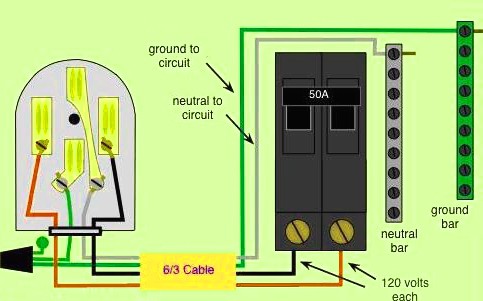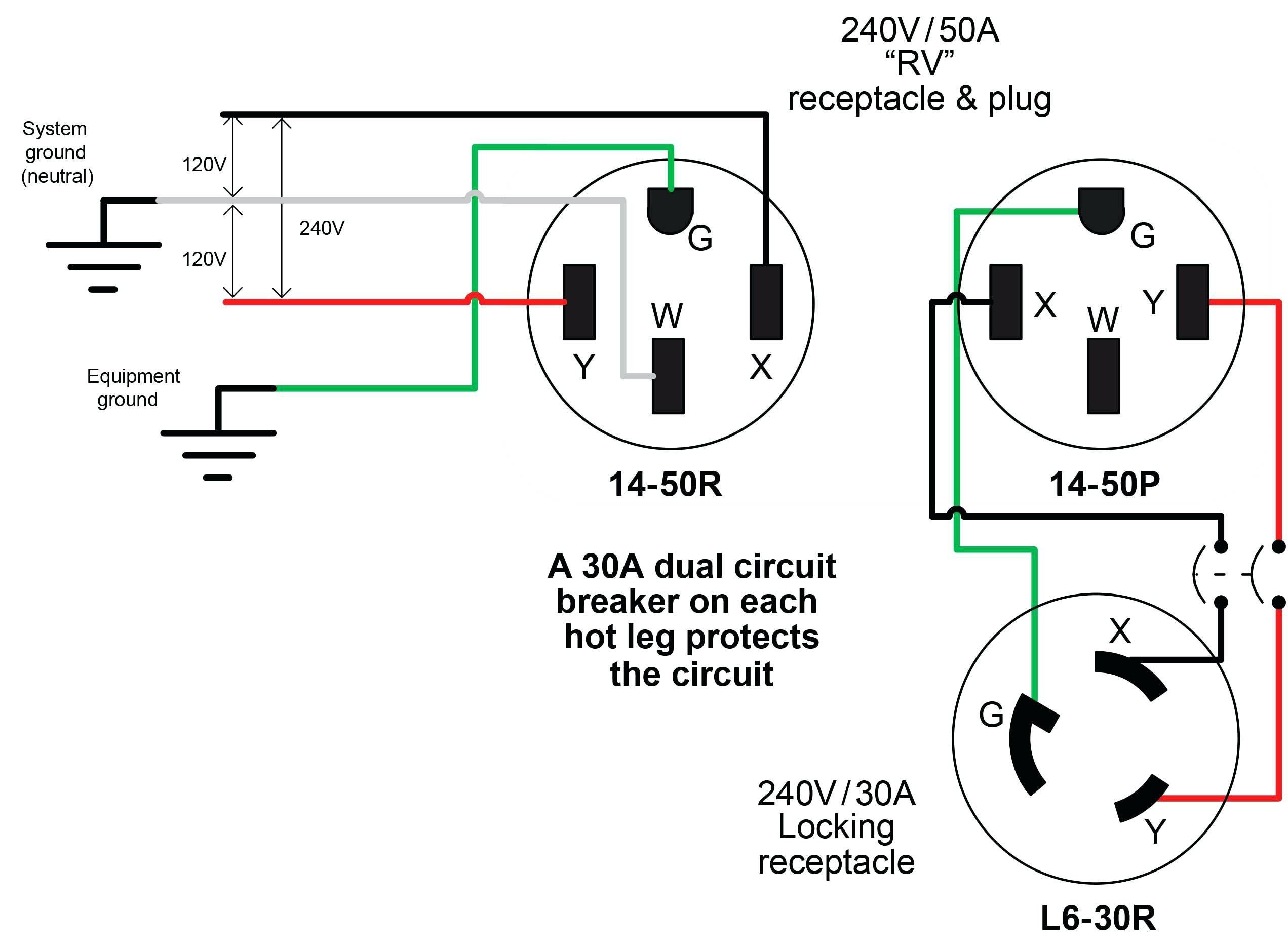To wire a 50 amp plug for an RV, you’ll need to connect the red and black wires to the hot terminals, the white wire to the neutral terminal, and the green or bare wire to the ground terminal. Ensuring proper electrical connections for your RV is crucial for safety and functionality.
Traveling with an RV brings the comfort of home to the open road, but it also demands attention to detail, especially when it involves electricity. Wiring a 50 amp RV plug is a task that can be undertaken by a DIY enthusiast with a good understanding of electrical safety protocols.
It’s essential to get it right to avoid electrical mishaps, as these can lead to dangerous situations like fires or equipment damage. Whether you’re setting up a new RV connection at home or replacing an old plug, a correctly installed 50 amp plug is the powerhouse that keeps your RV’s appliances and electronics running smoothly. Designed to handle the heavier electrical load, a 50 amp service provides the necessary power to support multiple appliances simultaneously, making your outdoor adventure both comfortable and convenient.
Introduction To Rv 50 Amp Wiring
Taking your RV on a road trip means anticipating the need for power. A 50 amp plug is a common requirement for the modern RV, providing the energy necessary to run multiple appliances and systems simultaneously. But wiring such a plug might seem daunting. This section will guide you through the basics of wiring a 50 amp plug for your RV, ensuring you’re ready for adventure with all the comforts of home.
Safety Precautions
Before diving into any electrical work, safety must come first. Working with electricity poses risks, including shock and fire hazards. Always ensure the power source is completely off before starting. Wear protective equipment like gloves and eye protection. Keep a fire extinguisher nearby in case of emergency. Understand and follow local codes and regulations. Finally, if unsure about any step, consult a certified electrician to prevent risk to yourself and your RV.
Tool And Material Checklist
Gather the right tools and materials before starting. Here’s a list of what you’ll need:
- Wire strippers
- Screwdrivers (flathead and Phillips)
- Socket set
- Voltage tester
- Rubber gloves for safety
- 50 amp RV plug
- 6/3 + 8/1 gauge electrical wire
- Electrical tape and wire nuts
Ensuring you have these handy will help streamline the installation process.

Credit: www.outdoorbits.com
Types Of 50 Amp Plugs For RVs
Understanding how to wire a 50 Amp plug for your RV is crucial for a safe and enjoyable trip. To do this, you first need to know about the different kinds of 50-amp plugs designed for RVs. Each has its characteristics and compatibility. Let’s explore these types and see how to choose the best fit for your RV setup.
Understanding RV Plug Configurations
RV plug configurations vary based on voltage requirements and grounding specifications. A 50 Amp RV plug typically has four prongs—two hot wires, one neutral wire, and one ground wire. This configuration is distinct from your regular home plug.
- Two hot prongs: Supply 120V each, for a combined 240V total
- Neutral prong: Completes the circuit
- Ground prong: Provides safety by preventing shocks
Choosing The Right RV Plug
Choosing the right 50 Amp RV plug is essential for ensuring compatibility and safety. Examine your RV’s power requirements before purchasing a plug. Look for a plug that matches your RV’s voltage and amperage specifications. Consider the shape of the plug prongs and receptacle to ensure a proper fit.
| Plug Type | Prong Shape | Compatibility |
|---|---|---|
| 14-50P | Flat prongs | Suits most RV parks |
| SS2-50P | Round prongs | For marine applications |
| CS6365 | Locking prongs | Industrial settings |
Look for UL-listed plugs to ensure quality and safety. Always make sure to follow local electrical codes and consult an electrician for proper installation. Never cut corners. Safety comes first.
Electrical Basics For Wiring A 50 Amp RV Plug
Getting ready to wire your RV for 50 amp service requires understanding the essentials of RV electrical systems. With the right knowledge and tools, you can ensure a safe and secure connection for your recreational vehicle.
Voltage, Amperage, And Wattage Essentials
Before diving into the wiring process, it’s critical to comprehend voltage, amperage, and wattage. These three elements form the foundation of electrical systems. For a 50 amp RV plug, the standard voltage is 240 volts when wired correctly; this is split into two 120-volt lines. Amperage refers to the electrical current’s strength, and 50 amps is what you’ll need for your RV’s plug. Wattage, meanwhile, is the product of voltage and amperage; thus, a 50-amp plug can handle up to 12,000 watts of power.
Wiring Color Codes
Properly wiring your RV plug means following the color codes for safety and functionality. Electrical wiring uses standard colors to indicate different wires:
- Black and Red wires – Represent hot wires and carry the current.
- White wire – Serves as the neutral wire.
- Green or Bare wire – Acts as the ground wire.
It’s essential to connect these wires correctly to prevent electrical hazards. Your RV plug’s terminals will be color-coded to match, ensuring you can wire the plug without confusion.

Credit: www.pinterest.com
Step-by-step Guide: Installing The 50 Amp Receptacle
Welcome to our handy step-by-step guide on installing a 50 Amp receptacle for your RV. Powering up your RV with a stable electricity source is crucial for a comfortable outing. With clear instructions and attention to safety, you can easily set up a secure connection. Let’s get that 50 Amp plug up and running following these decisive steps.
Mounting The Box
Select a spot on your RV panel that is free from any obstructions. Mark the area where you will fix the box. Drill holes and fit the box securely against the RV panel. Use screws to ensure the box is firmly in place. Ensure the box is both accessible and protected from the elements.
Connecting The Wires
- Turn Off the Power: Begin by ensuring that the power to your RV panel is completely off.
- Prepare the Wires: Open the new 50 Amp receptacle box. You should see four terminals labeled respectively.
- Strip the Wires: Use a wire stripper to expose the copper ends of your wires.
- Connect the Wires: Attach the red and black wires to the hot terminals, white to neutral, and green to ground.
- Secure the Connections: Tighten all the screws on the terminals to secure the wires in place.
- Anchor the Receptacle: Place the receptacle within the mounted box, ensuring a snug fit.
- Finalize the Installation: Close the receptacle box cover. Double-check all connections are tight and secure.
- Restore Power: Turn the power back on and test the receptacle with a voltage tester to confirm the installation.
By following these steps, you ensure a safe and reliable power source for your RV, ready for any adventure awaiting you.
Wiring The 50 Amp RV Plug
Wiring a 50 Amp plug for your RV is a skill that can save you time and money. Being able to connect your RV to a 50 Amp plug ensures you can access full power wherever your travels take you. Here’s a step-by-step guide to get it done right.
Striping The Wires
Before attaching the plug, you need to prepare your wires. This means removing the outer insulation without damaging the inner wires.
- Use a wire stripper to carefully remove about 3/4″ of insulation from each wire.
- Do this for the red, black, white, and green wires.
- Make sure each wire is clean and straight for secure attachment.
Attaching The Plug Terminals
Attach the wires to their respective terminals very carefully. Correct wiring is crucial for safety and functionality.
- Loosen the terminal screws on the plug.
- Attach each wire to the matching terminal:
- Red goes to the right terminal.
- Black is for the left terminal.
- White connects to the middle terminal.
- Green or bare wire to the ground terminal.
- Tighten each screw to secure the wires firmly.
Double-check that each connection is correct and tight. Safety comes first, always follow the color-coded standards for wiring your RV plug.
Credit: www.forestriverforums.com
Testing The Installation For Safety
After wiring a 50 Amp plug for your RV, testing for safety is crucial. This step ensures everything is in perfect order before use. You will need a multimeter and some knowledge of common issues that might arise. Let’s get started.
Using A Multimeter
A multimeter helps to check voltage, amperage, and continuity. Follow these simple steps:
- Set your multimeter to the correct measurement.
- Attach the multimeter’s leads to the corresponding terminals in the plug.
- Check the reading against expected values for a properly wired 50 Amp RV circuit.
- The correct reading should be around 240 volts for a 50-amp service.
Troubleshooting Common Issues
If readings are not as expected, here’s how to troubleshoot:
- Ensure all connections are secure and correctly made.
- Verify that there are no loose wires or exposed conductors.
- Check the breaker and ensure it’s properly rated for 50 Amp service and not tripped.
Common issues can include incorrect voltage readings or no power at all. Ensure no wires are crossed and confirm you’ve followed all steps properly.
Remember, safety comes first, and if uncertain, consult a professional electrician.
Maintaining Your RV’s Electrical System
Keeping your RV powered up for the journey ahead means staying on top of the electrical system. Regular check-ups and fixes ensure everything from your coffee maker to your AC runs smoothly.
Regular Inspection And Upkeep
Maintaining your RV’s electrical system is key to a stress-free adventure. Follow these steps:
- Check connections for wear and tightness.
- Look for signs of overheating or corrosion.
- Secure all cables and ensure they are properly insulated.
- Test your 50 amp plug to confirm it’s providing the correct voltage.
- Clean and tighten your RV’s shore power connector regularly.
Utilize a voltage meter to prevent power surges and multimeter checks for consistent current.
When To Seek Professional Help
Some electrical issues in your RV are best left to professionals. Be aware of these signs:
- Frequent electrical surges or breaker trips
- Strange odors or noises from outlets or appliances
- Inconsistent power supply, dimming lights, or weak appliance performance
- Any sparks or smoke when connecting your RV to the power
Contact a certified RV technician if these problems arise. Ensure safety and efficiency by getting timely help.
Common Mistakes To Avoid
Wiring a 50 amp plug for your RV is a critical task. Mistakes can lead to safety hazards. Learn common errors to avoid and ensure a safe connection for your adventures.
Incorrect Wire Size And Type
Selecting the right wire is imperative for safety. Ensure you use:
- 6-gauge wire for most 50 amp RV plugs.
- Type THHN or THWN wire resistant to heat and moisture.
Using too thin or the wrong type of wire can cause:
- Overheating poses a fire risk.
- Electrical failure in your RV’s systems.
Poor Connection Practices
Ensuring secure connections is non-negotiable. Remember:
- All screws and terminals must be tight.
- Never leave exposed wire at connection points.
- Use wire strippers, not knives, to strip insulation.
Poor practices can lead to:
- Electrical shorts and sparks.
- Damage to your RV’s electrical system.
- Potential electric shocks to users.
Appendix: Wiring Diagrams And Additional Resources
Embarking on the DIY journey to wire a 50 Amp plug for your RV can be a challenging venture. To aid with this task, an appendix of wiring diagrams and additional resources becomes invaluable. Use these tools to ensure a safe and correct installation. Remember, electrical work requires precision and understanding, so never hesitate to consult a professional if in doubt.
Sample Wiring Diagrams
Visual aids are crucial when working with complex tasks such as wiring. Below are some simplified diagrams to guide you through the process:
- 4-Wire 50 Amp Plug Diagram: Shows connections for both the RV and the power source.
- Terminal Connectors Guide: Illustrates which wire connects to each terminal.
Always double-check your RV’s manual for specific wiring requirements.
Online Resources And Communities
Online forums and platforms provide a wealth of information. They also offer community support for your wiring endeavors. Below are some places to find assistance:
| Resource | Description | Link |
|---|---|---|
| RV Forums | User discussions on RV repairs and modifications. | [Forum Website] |
| DIY Blogs | Detailed articles on RV electrical systems. | [Blog Website] |
| YouTube Channels | Step-by-step installation videos from experts. | [YouTube Channel] |
Keep in mind to only follow advice from reputable sources.
Conclusion
Wiring a 50-amp plug for your RV doesn’t have to be daunting. With the right tools and a clear understanding of the steps, you can ensure a safe and robust connection for your travels. Remember to always prioritize safety by double-checking connections and following electrical codes.
Happy RVing, and enjoy a well-powered journey ahead!

